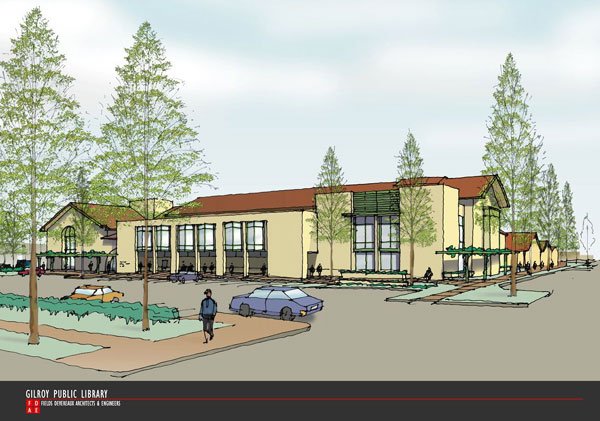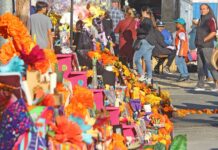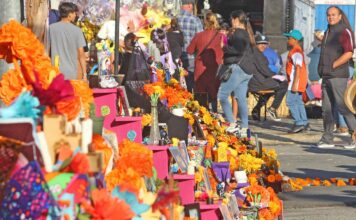Gilroy
– The city is asking residents to step up to the plate and help
secure state funding for construction of a new Gilroy library.
In partnership with the Gilroy Unified School District and the
Santa Clara County Library, the city is launching a letter-writing
campaign aimed at netting $14 million of the state’s library
construction grant fund.
Gilroy – The city is asking residents to step up to the plate and help secure state funding for construction of a new Gilroy library.
In partnership with the Gilroy Unified School District and the Santa Clara County Library, the city is launching a letter-writing campaign aimed at netting $14 million of the state’s library construction grant fund.
The money would help construct a brand new, 53,000-square-foot library – more than four times the size of the current facility.
“We have high hopes for this grant, but we need the help,” said City Councilman Bob Dillon, who is Gilroy’s representative on the joint powers authority for the Santa Clara County library system.
The campaign to Get on the BAL – Build a Library – encourages all Gilroy residents to write a letter to the state librarian explaining why Gilroy needs a new library, and what the library means to Gilroyans.
The letters will be collected through the end of October, then copied and forwarded to each member of the California Public Library Construction and Renovation Board. That organization will decide later this fall which libraries get the grants.
“The library is truly a place for community. Everyone is welcome here, and people of all walks of life use the library,” said community librarian Lani Yoshimura.
When the current 12,500-square-foot library opened in 1975, it housed about 57,000 items and no computers. Seating accommodated 125 people.
Now, the library has more than 126,000 items in multiple media formats and 28 computers. To make room for the additions, the library’s seating was reduced to 85.
The library reached its 85,000 book capacity in 1979, Yoshimura said.
The new, two-story library will support 266,000 items in multiple media formats and will have 105 computers, offering both word processing and Internet access. Individual seating will accommodate almost 350 people, and enlarged meeting spaces will accommodate about 250 more seats.
The new library also will offer more Spanish and international language materials, more parking, community bulletin boards, a cafe, better lighting and improved access for the disabled. Special-use spaces will be available for community meetings, group and individual study sessions, and Alternatives Schools tutoring for at-risk youth and their families. Schools, the library and the city will be connected through a Cable-TV network called INET.
The library also will have an outdoor reading area and an after-hours facility for community meetings and Friends of the Library fund raisers.
More than 1,000 people per day currently go through the library’s doors, Yoshimura said. That number is expected to double if the new library is built, to total about 715,000 patrons per year.
California voters in 2000 approved $350 million for renovation and construction of libraries statewide, to be distributed in three rounds. Gilroy was edged out in the last two cycles.
Mayor Al Pinheiro called the third grant cycle “the big push,” but this go-round may be the toughest yet: 72 libraries statewide are vying for a share of the available $76 million, and the average grant request is about $8 million.
During the second grant cycle, 66 libraries applied for an available $110 million. The average request then also was about $8 million.
“We have to be mindful of the fact that we’re asking for more than a lot of the other communities,” Pinheiro said. “We have to show that we’re getting the most bang for our buck, and it’s up to us to show them what we’re going to do with that money.”
The new library’s total cost is $21 million. If Gilroy’s library gets the $14 million grant, about $5 million of the difference will be covered by the city’s library development impact fees and about $2 million by county library funds, said the city’s facilities manager Bill Headley.
But should the third try for the grant end up like the last two, Headley said it’s mostly a dead end.
“Unlike some other cities, we don’t have other revenue sources. There’s no alternative funding to build this library,” he said. “We’d continue to see what we could do with the limited funds we have from the impact fees and the county, but those resources are very limited.”
A bill for another library bond is on Gov. Arnold Schwarzenegger’s desk now, Headley said. But even if that bill gets signed, taxpayers still have to approve it – an unlikely prospect considering all the other facets of state debt, Headley said.
Fortunately, Headley said, the Gilroy Library enjoys an advantage over many other communities: It has partnered with GUSD and the Santa Clara County Library since 1957.
Cecilia Del Buono Weymouth, a retired GUSD teacher, emphasized that the city’s demographics are well served by the current library’s bilingual and technological offerings. But the need for bilingual and computer access far outweighs what the current library can provide, she said.
“For children who come from low-income households, the only place they have access to computers is the library,” she said. “Another consideration is that many immigrants are having to register online now, and that’s typically a disadvantaged group of people. The library is the greatest place for them to do that.”
The new library was designed by Los Angeles-based Fields Devereaux Architects and Engineers, a firm known for its environmentally friendly designs of public and educational facilities, Headley said. The new facility will incorporate sustainable building strategies to reduce energy consumption and use more natural light.
To gather community input about what the new library should look like, the city’s library commission held several public meetings and distributed surveys to Gilroy residents and schools over the past few years. The final design is reflective of what Gilroy residents want in their library, said Gilroy Library commissioner Bud Burchell.
“It was the most democratic working of a committee that I’ve ever seen,” he said. “The end result is that we have a library truly designed by the people of Gilroy.”














